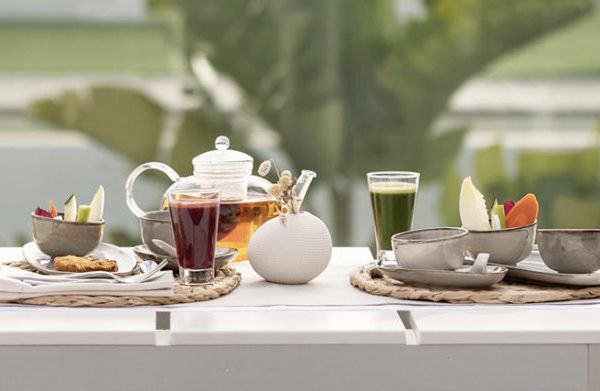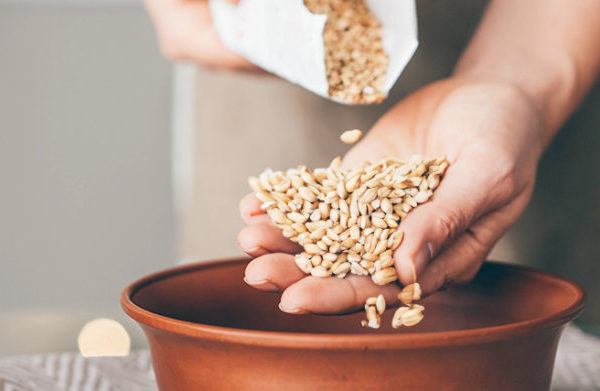
SHA Magazine Healthy Nutrition
Keys for Healthy Eating by Melanie Waxman
Melanie Waxman, Specialist in Natural Therapies and Nutrition Consultant in SHA talks about healthy eating nowadays, possible allergies and food intolerances.
- What do you think about food intolerance test? Is it important for everybody to do this test? Can we regard it as main condition of healthy way of feeding?
I don’t feel it is necessary for everyone to do these tests. The body changes all the time and so one day an intolerance appears and a few weeks later it doesn’t show up. These tests are useful for those who have apparent symptoms and want to clarify the possibility of a strong allergy or intolerance.
- Everyone knows that drinking water (1,5-2 liters/day) is important for a healthy lifestyle. Which time is the best for drinking? Which temperature of water is the best for us? What about silver water?
Water can be enjoyed throughout the day but not during meals. It is best to stop 30 minutes before a meal and then continue after the meal is finished. Room temperature water is ideal. Silver has been long used as a biocide and can be purchased in the form of colloidal silver which is used for cuts, colds, infections etc. Putting pure silver into water might prevent the build- up of bacteria but the coins could also leech alloys if they aren’t pure. Using a good water filter or fresh spring water might be a preferred option.
- Howard Murad, author of«The Water Secret: The Cellular Breakthrough to Look and Feel 10 Years Younger», says we can hydrate our body by eating certain foods (cucumbers, pomegranates, avocados…) or «eat water. From his point of view water from fruits and vegetables is better because it is available to our cells throughout the day. Which is your opinion?
Some vegetables and fruits can hydrate the body twice as effectively as a glass of water as they also contain hydrating salts, minerals, amino acids and sugars. Cucumbers, celery, and watermelon have some of the highest water content. To be properly hydrated, you need to replace the fluid that is lost from the body. Fruits and vegetables contain the minerals and sugars that mirror body fluid and can hydrate more effectively than water alone. A plant based diet naturally provides hydration for the body and as a result less water is needed although it is still important have some during the day.
- Gluten-free diet. Are there special nutritional benefits which gluten offers? The risks of going gluten-free (for those who have no intolerance). And what about lactose-free diet?
Gluten is high in protein and low in fat. It is also high in iron and has trace amounts of calcium. It doesn’t raise cholesterol levels. There are no risks for lactose-free diet.
- Are there any health risks in macrobiotics?
The macrobiotic diet contains a wide range of organic, fresh foods, ingredients, and cooking styles that provide a highly nutritious and balanced way of eating. The diet is rich in vegetable proteins, complex carbohydrates, minerals and vitamins. Most of the foods come straight from the fields rather than a factory and are whole right up until they are cooked or eaten. The ingredients are full of antioxidants, energy and nutrition. The diet can be adapted to suit a person’s lifestyle, work, activity, culture, climate, environment and age etc. The only risk would be if someone didn’t include the full variety of foods and ate a very simple diet with little fat or protein for a long period.
- Are there any forms of healthy desserts? Which is the main down by of eating sweet food after dinner? Which is the best time for eating sweets?
There are many wonderful sugar-free desserts that can be enjoyed from simple puddings and fruits, to pies and cakes. Mildly sweetened desserts can help us to feel more relaxed and soothed. However, too many sweets and sugar have the opposite affect and lead to blood sugar issues, low energy, emotional ups and downs, and can contribute to more serious diseases of the heart and cancer. The best time to have sweets is after lunch although the size of the dessert is probably more important. Small portions of dessert can be enjoyed at lunch or dinner. Waiting at least 15 minutes after a meal to have dessert is best. For those with more sensitive digestive systems, fruit and desserts can be enjoyed in the earlier part of the day.
- The risks of raw-foodism. Can heat treating make the product more healthful? (for ex., like when we heat-treat tomato, we release licopin).
Cooking makes food more digestible, changes the taste and texture, provides warmth and energy, and makes certain nutrients more accessible for the body.
- The risks of low-fat diet. What kind of fatty acidspromote weight loss (by participating in metabolism)?
The main foods that promote weight loss are those rich in Omega 3 as leafy greens, nuts especially walnuts, chia seeds, salmon, oysters, flax seed oil, basil, oregano, broccoli etc.
- Which is the healthiest way of drinking green tea. (Mongols for ex. boil the tea for 30 minutes to create a richer taste, the Chinese water down it many times… )
It seems that green tea varies from one culture to another and is probably adjusted to suit the differing climates. The key is the temperature of the water. The flavor of green tea is enhanced if the boiled water is allowed to cool slightly (for around 3 minutes) before adding it to the leaves. Green tea can then be steeped for 1-3 minutes for a light refreshing flavor. The longer it is steeped the more bitter the flavor.
- We know many benefits of quitting caffeine or coffee. But can it have negative sides? Are there people who need caffeine and what could be a reason for it? Advantages and disadvantages of non-caffeine coffee for our health. Yerba mate (mate) like alternative to coffee.
I have never had coffee in my life and don’t feel it is good for health. However, some claim that coffee is high in antioxidants, and can help prevent diabetes, and lower the risk of prostate and breast cancer. Decaffeinated coffee is more harmful as it is highly acidic, often contains chemical solvents from the processing, and antioxidants are lost during extraction. Coffee alternatives using chicory, dandelion and roasted maca are great for boosting the immune, and can help to reduce inflammation, and improve digestion.
- The risks and advantages of fasting.
Juice fasts are wonderful as a detox for short periods of time of up to three days or so. Fasting for too long can make you feel weak, and lose energy. Fasts in general are not good for diabetics, or those who have active infections, emotional instability, heart problems, cancers or pregnant women. The advantages of fasting includes, cleansing of the filtering organs such as liver, kidneys, and lungs, weight loss, discharging accumulated toxins, improved clarity of thinking, more energy, and a rest for the digestive system.
- The risks of stop eating red meat. Are there any vitamins or nutrients which we can find only in red meat (like L- carnitine for ex).
No risks for stopping meat as long as you include vegetable protein and fats such as beans, nuts, seeds, oils, nuts, cereals, vegetables, fruits and sea vegetables. Fish can also be included as part of a healthy diet.
- What do you think about ayurvedic cooking? Is it good for Europeans or not?
The basic principles of ayuvedic cooking are very similar to macrobiotics. The food is fresh, pesticide/chemical free, local, seasonal, and freshly cooked. It can be adjusted to suit differing climates and conditions. It can easily be adjusted to suit Europeans.
- Which is the healthiest way of feeding in nordic countries? (In Russia for example) What kind of healthy products could help us to stay warm in winter?
It is possible to create strong, warm, energy giving dishes without using meat or dairy. These would include hearty vegetable soups from beans, root vegetables, pumpkin, or fish. Oil can be added for extra richness. Dishes from whole grains especially brown rice, buckwheat and millet (porridge, crepes, fritters, fried with vegetables). All kinds of fish including fatty varieties such as salmon, mackeral or sardines. Also long sautéed vegetables, pickles (sauerkraut), miso soup, nuts, nut butters, some deep fried vegetables, more oil, and dark breads. Lightly cooked greens or other vegetables can be included to add freshness. In very exteme, cold, climates, some animal food might be necessary. In that case eggs twice a week, meat cooked into a stew every week, and fresh cheese twice a week if craved. The key is to have much smaller portions of animal and dairy foods and cook them with lots of vegetables in a stew or soup.





